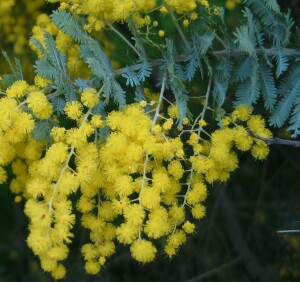Community weed warrior releases Cootamundra Wattle brochure
Posted on 12 January, 2022 by Ivan
Cootamundra Wattle (Acacia baileyana) is a colourful character. It is often used in landscaping for its showy floral blooms and strong foliage, and was a common backyard planting over the past few decades. Unfortunately in our climate, this species often escapes into the woodlands and the forests of central Victoria, invading bushland and displacing the plants indigenous to our area.
The invasion of the Cootamundra Wattle can be seen throughout Kalimna Park in Castlemaine, as well as many pockets of bushland near our townships. However, as a local weed warrior recently discovered, the Cootamundra Wattle could also cause the extinction of our native Silver Wattle in some areas. This valiant community member recently created a brochure outlining the threats posed by the Cootamundra Wattle on our local populations of Silver Wattle, as well as how to identify both species.
To view and download the Cootamundra Wattle brochure (PDF format) – click here
Thank you for sharing your amazing work and informative brochure! A brief summary is provided below.
Cootamundra Wattle harms local native species
Silver Wattle (Acacia dealbata) is indigenous to Mount Alexander region and before Europeans arrived, it grew naturally along waterways and gullies. Cootamundra Wattle (Acacia baileyana) is native to a small area west of Cootamundra in central New South Wales, and was introduced as a garden plant to many areas outside its natural range. The problem is that it crosses with Silver Wattle. This means that the seeds produced by Silver Wattles growing near Cootamundra Wattle no longer produce Silver Wattle seedlings but a cross between the two species.
Distinguishing between wattles
In our part of central Victoria, Silver Wattle is a tree up to about 10 m (taller in wetter regions) with greyish-green leaves and fairly upright clusters of yellow flowers in July to September. It often suckers. Cootamundra Wattle is a shrub or small tree about 3-6 m high with silvery-grey leaves and dense, hanging clusters of bright yellow flowers in July to August. Its leaves are shorter than Silver Wattle leaves, with fewer leaflets. It does not sucker. Both have bipinnate (fern-like) leaves.
What you can do to help Silver Wattle
- Do not plant, sell or give away Cootamundra Wattle plants.
- Cut down any Cootamundra Wattles (including hybrids) on your land. Cutting them down before they seed will prevent another season’s seeds joining the soil seed bank.
- Do not put seeds from cuttings in green waste collections, as this will spread the seeds.
- Ask your local council to remove any Cootamundra Wattles from your nature strip.
- Ask Parks Victoria or Department of Environment, Land, Water and Planning to remove them from public land.
- Politely explain the Cootamundra Wattle problem to people who don’t know about it, and ask plant sellers (including at markets) not to sell Cootamundra Wattles. Although some forms are claimed to be sterile, this is difficult to verify and they still popularise Cootamundra Wattle.
- Encourage people to grow local native wattles like Golden Wattle (Acacia pycnantha) and Wirilda (Acacia provincialis) instead.
To learn more, read the brochure – click here








I have a patch of 8 to 10 Cootamundra wattle trees under Yellow and Grey box. I have recently noticed that there are no grasses or other small plants growing under them which are abundant nearby. I don’t know if it’s the reduced light or something else causing this.
Thanks Kevin, quiet a few of the Acacia species have allelopathic traits that allow them to compete with other species, and not have plants growing below them!